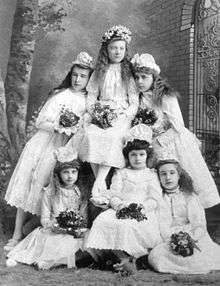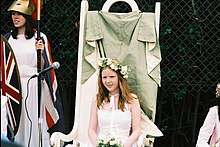May Queen
The May Queen or Queen of May is a personification of the May Day holiday, and of springtime and also summer. The May Queen is a girl who rides or walks at the front of a parade for May Day celebrations. She wears a white gown to symbolise purity and usually a tiara or crown. Her duty is to begin the May Day celebrations. She is generally crowned by flowers and makes a speech before the dancing begins. Certain age-groups dance around a Maypole celebrating youth and springtime.

History
James George Frazer speculated that the figure of the May Queen was linked to ancient tree worship.[1]
In the High Middle Ages in England the May Queen was also known as the "Summer Queen". George C. Homans points out: "The time from Hocktide, after Easter Week, to Lammas (1 August) was summer (estas)."[2]
In 1557, a London diarist called Henry Machyn wrote:
"The xxx day of May was a goly May-gam in Fanch-chyrchestrett with drumes and gunes and pykes, and ix wordes dyd ryd; and thay had speches evere man, and the morris dansse and the sauden, and an elevant with the castyll, and the sauden and yonge morens with targattes and darttes, and the lord and the lade of the Maye".
Modern English: On the 30 May was a jolly May-game in Fenchurch Street (London) with drums and guns and pikes, The Nine Worthies did ride; and they all had speeches, and the morris dance and sultan and an elephant with a castle and the sultan and young moors with shields and arrows, and the lord and lady of the May".[3]
Maintaining the tradition

Many areas keep this tradition alive today. The oldest unbroken tradition is Hayfield, Derbyshire,[4] based on a much older May Fair. Another notable event includes the one in the Brentham Garden Suburb, England, which hosts it annually.[5] It has the second oldest unbroken tradition although the May Queen of All London Festival at Hayes Common in Bromley is a close contender having been in existence for 105 years as of 2017. A May Day festival is held on the village green at Aldborough, North Yorkshire on a site that dates back to Roman times and the settlement of Isurium Brigantum. A May queen is selected from a group of 13 upward girls by the young dancers. She returns the next year to crown the new May Queen and stays in the procession. The largest event in this tradition in modern Britain is the Beltane Fire Festival in Edinburgh, Scotland.
A May Day celebration held annually since 1870 in New Westminster, British Columbia, Canada, has the distinction of being the longest running May Day celebration of its kind in the British Commonwealth.[6]
See also
- May crowning
- The Green Man
References
- Frazer (1922), The Golden Bough, ch. 10 "Relics of tree worship in modern Europe"; Frazer quotes Mannhardt: "The names May, Father May, May Lady, Queen of the May, by which the anthropomorphic spirit of vegetation is often denoted, show that the idea of the spirit of vegetation is blent with a personification of the season at which his powers are most strikingly manifested."
- Homans, English Villagers of the Thirteenth Century, 2nd ed. 1991:354.
- Nichols, J. G. (ed). (1848). The Diary of Henry Machyn: Citizen and Merchant-Taylor of London (1550-1563). Retrieved 11 February 2007.
- Hayfield.uk.net Archived 2010-07-10 at the Wayback Machine
- "May Day". Retrieved 14 November 2014.
- New Westminster Hyack Festival Association (2004). "Hyack Festival Events". Archived from the original on 2005-08-25. Retrieved 2006-01-03.
External links
- A translation of Grimm's Saga No. 365 about Hertha, Mother Earth, and a web essay on how she became the May Queen
- Freya, May Queen with references, songs and customs